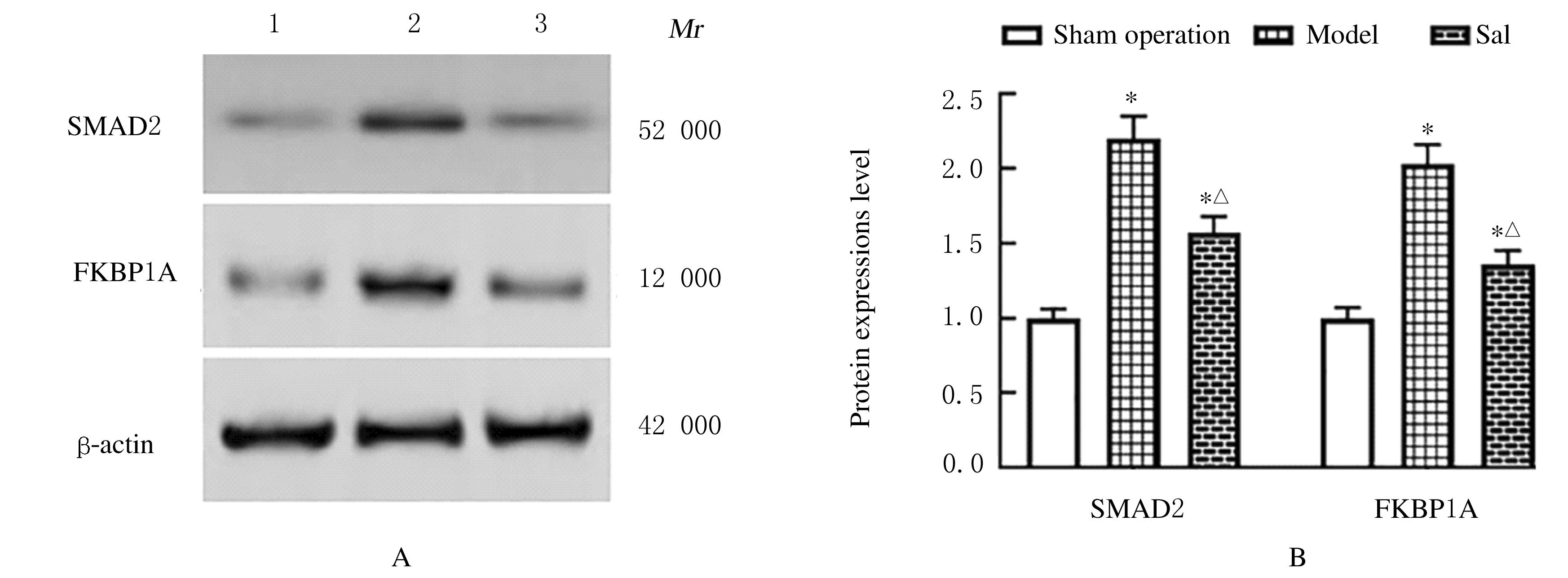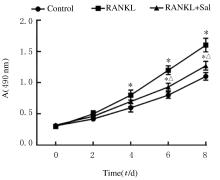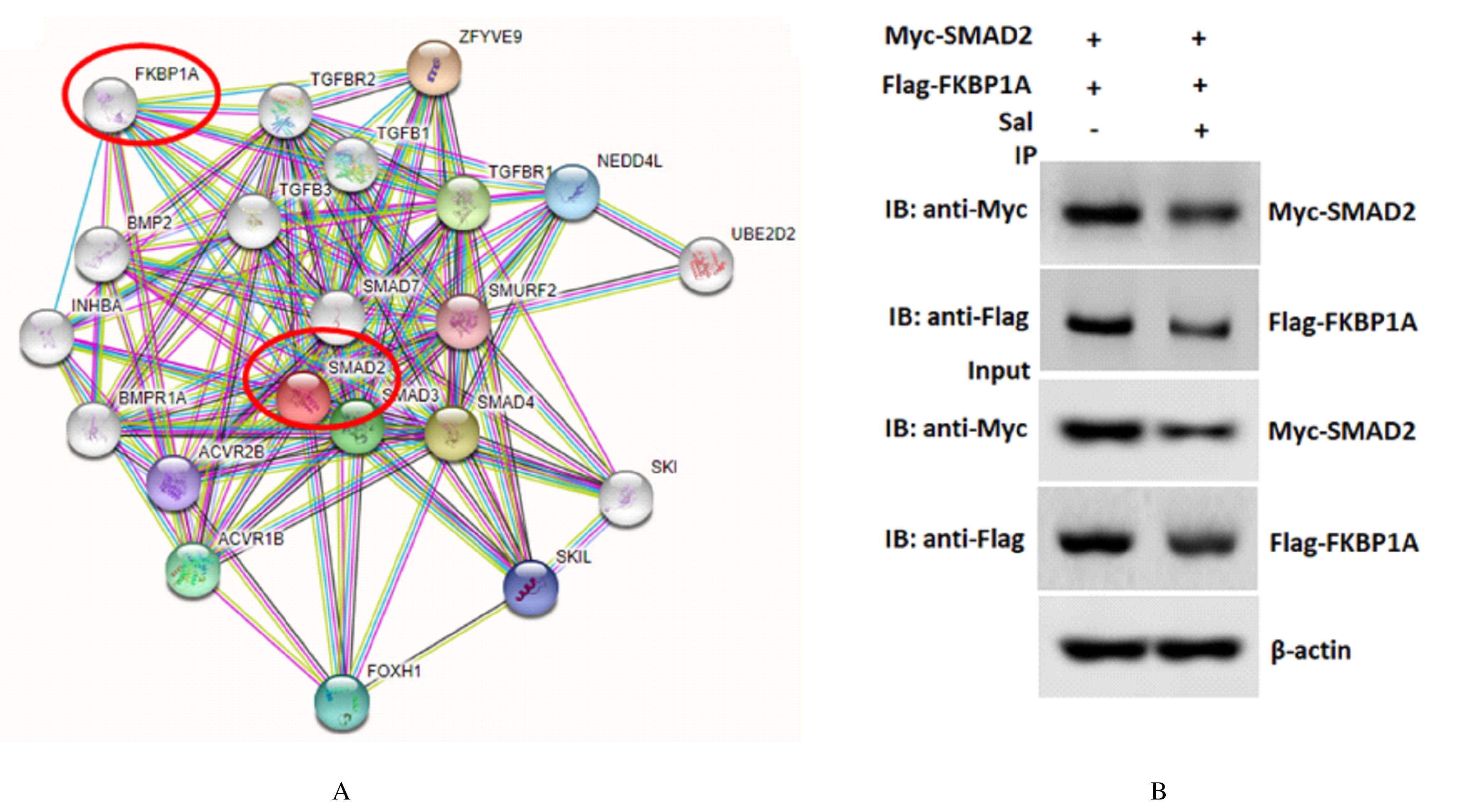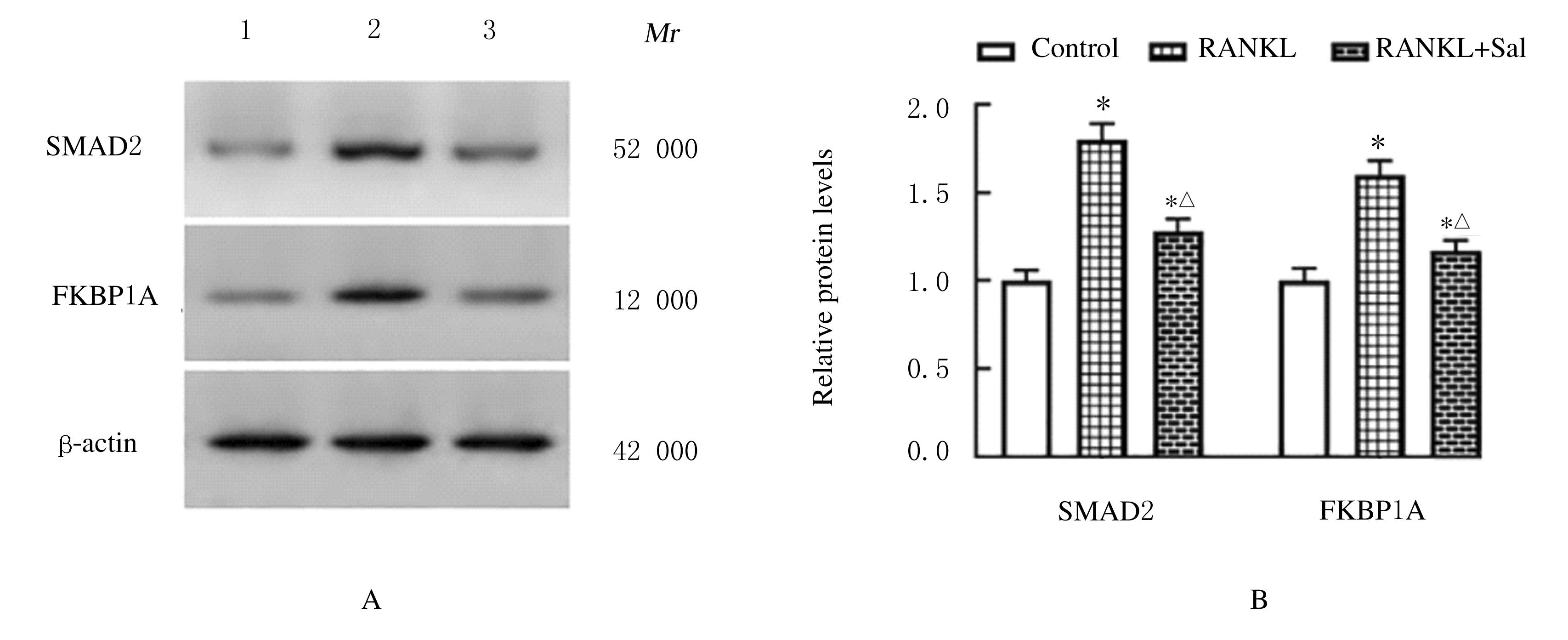吉林大学学报(医学版) ›› 2022, Vol. 48 ›› Issue (1): 111-121.doi: 10.13481/j.1671-587X.20220114
丹参多酚酸酯调控SMAD2/FKBP1A/NF-κB轴对骨质疏松症大鼠破骨细胞分化和骨吸收的影响
马运锋1,韩小飞2
- 1.河南中医药大学第二附属医院 河南省中医院骨病一科,河南 郑州 450002
2.河南中医药大学第二附属医院 河南省中医院风湿病科,河南 郑州 450002
Effects of salvianolate on osteoclast differentiation and bone resorption in osteoporotic rats by regulating SMAD2/FKBP1A/NF-κB axis
Yunfeng MA1,Xiaofei HAN2
- 1.Department of Osteopathy,Second Affiliated Hospital,Henan University of Traditional Chinese Medicine,Henan Provincial Hospital of Traditional Chinese Medicine,Zhengzhou 450002,Henan
2.Department of Rheumatology,Second Affiliated Hospital,Henan University of Traditional Chinese Medicine,Henan Provincial Hospital of Traditional Chinese Medicine,Zhengzhou 450002,Henan
摘要: 探讨丹参多酚酸酯(Sal)对骨质疏松症大鼠破骨细胞分化和骨吸收的影响,阐明其作用机制。 体内实验,采用去势法建立骨质疏松症大鼠模型,30只雌性大鼠随机分为假手术组、模型组和Sal组(建模4周后隔天腹腔注射40 mg·kg-1 Sal,共4周)。采用HE染色法观察各组大鼠股骨组织病理形态表现,双能X射线骨密度仪检测各组大鼠股骨骨密度(BMD),三点弯曲试验检测各组大鼠股骨最大载荷。体外实验,采用30 μg·L-1巨噬细胞集落刺激因子(M-CSF)和100 μg·L-1核因子κB(NF-κB)配体(RANKL)诱导骨髓巨噬细胞(BMMs)分化,细胞分为对照组、RANKL组、RANKL+Sal组(10 mg·L-1Sal)、RANKL+Sal+空载体(vector)组(10 mg·L-1 Sal和2 mg·L-1 vector)、RANKL +Sal +LV-FKBP1A组[10 mg·L-1 Sal和2 mg·L-1 慢病毒介导的FKBP1A过表达载体(LV-FKBP1A)]、RANKL +Sal +LV-FKBP1A+QNZ组(10 mg·L-1 Sal、2 mg·L-1 LV-FKBP1A和10 nmol·L-1NF-κB抑制剂QNZ),MTT法检测各组细胞增殖活性,流式细胞术检测各组细胞凋亡率,Co-IP实验验证SMAD2和FKBP1A的相互作用,Western blotting法检测各组大鼠骨组织和各组细胞中SMAD家族蛋白2(SMAD2)、FK506结合蛋白1A(FKBP1A)和磷酸化核因子-κB P65(p-P65)蛋白表达水平,酶联免疫吸附试验(ELISA)检测各组大鼠血清和各组细胞中抗酒石酸酸性磷酸酶5b(TRAP5b)水平,实时荧光定量PCR(RT-qPCR)法检测各组大鼠骨组织和各组细胞中组织蛋白酶K(CTSK)和降钙素受体(CTR)mRNA表达水平。 体内实验,与模型组比较,Sal组大鼠骨小梁数量明显增加,大鼠股骨BMD和最大负载明显升高(P<0.01),血清中TRAP5b水平明显降低(P<0.01),骨组织中SMAD2及FKBP1A蛋白表达水平和CTSK及CTR mRNA表达水平明显降低(P<0.01)。Co-IP实验结果证实SMAD2与FKBP1A蛋白存在相互作用。体外实验,与RANKL组比较,RANKL+ Sal组细胞增殖活性明显降低(P<0.01),细胞凋亡率明显升高(P<0.01),细胞中TRAP5b水平,SMAD2、FKBP1A及p-P65蛋白表达水平和CTSK及CTR mRNA表达水平明显降低(P<0.01);与RANKL+Sal+vector组比较,RANKL+Sal+LV-FKBP1A组细胞凋亡率明显降低(P<0.01),细胞中TRAP5b水平,SMAD2、FKBP1A及p-P65蛋白表达水平和CTSK及CTR mRNA表达水平明显升高(P<0.01);与RANKL+ Sal+LV-FKBP1A组比较,RANKL+ Sal+LV-FKBP1A+QNZ组细胞凋亡率明显升高(P<0.01),细胞中TRAP5b水平,SMAD2、FKBP1A及p-P65蛋白表达水平和CTSK及CTR mRNA表达水平明显降低(P<0.01)。 Sal通过调控SMAD2和FKBP1A蛋白的相互作用,抑制NF-κB活化,缓解大鼠骨质疏松症。
中图分类号:
- R274.9
















